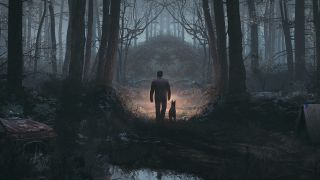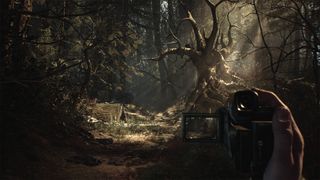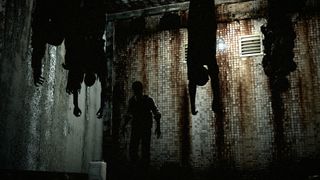Blair Witch is further proof of why the portrayal of 'insanity' in video games needs to evolve
The trivialisation of mental health in gaming continues with Blair Witch, and something has to change


Dialogue Options: Should video games cover sensitive subjects?
It's almost impressive how disappointing Bloober's recent Blair Witch turned out to be. While the experience never really feels like you're playing a Blair Witch game, it does look exactly the way you'd want a game bearing the Blair Witch name to look; a franchise, it should be said, that has long struggled to replicate the 1999 film's unique collision of icky New England folklore and the searing terror of isolation, either on screen or in game. Bloober's game sounds the part, too. Never, in the history of video games, has the noise of a wet branch cracking echoed so ominously, ringing off like a warning that something terrible is primed to happen.
A problem is, of course, that this is a game where something terrible only very rarely happens. In fact, Blair Witch's frequent game breaking bugs are scarier than anything the narrative offers. For the most part, it's an aimless trawl through identikit woodland, accompanied by a dog that, should it ever be forced to sit down and take dog A-Levels, would unquestionably leave well short of the requisite qualifications needed to attend dog university.

It's a game that is every orienteering course you were ever tasked with taking in Boy Scouts, only without the promise of a hot chocolate at the end of it all. And yet the most disappointing thing about the new Blair Witch game isn't any of this. Rather, it's the incorporation – no, it's central placement – of a trope as enduringly frustrating as they come; 'insanity' as a game mechanic. Essentially, 'is something terrible happening here… oh no, the protagonist has become mentally ill'.
Fittingly, for the genre the game belongs to, horror loves itself a bit of this nonsense. 2010's Shutter Island and 2003's High Tension were two good films, spoiled by the appearance of said tropes in their final moments. Literary horror icon Stephen King is a fan, often deploying it to get him out of a narrative dead end (though blame for its inclusion in Stanley Kubrick's 1980 reinvention of The Shining lies solely with the director and his writing partner Diane Johnson). There is no shortage of other culprits who weren't listening when a teacher told them that 'it was all just a dream' wasn't an acceptable way to end the stories they wrote at school.
The big bad of gaming

Poor mental health has long been video games' biggest bad. It forms the crux of the Silent Hill series, with the characters within Konami's broken world battling monsters who reflect the fractured psyches of themselves. It's an effective device – Silent Hill 2 would make any list headed The Greatest Horror Video Games Ever – but while it would be a leap to say the device is especially harmful, it's certainly regressive. It enforces the view that people who are mentally ill are 'other', they're not like us, they're in the petri-dish and we're examining them. What we should be pitching for, for the well-being of all, is that mental health, good and bad – to use rudimentary terms – exists on a spectrum across us all.
The first game in the Silent Hill series is twenty-years old, though, so how far have we come since then? Vaas, Pagan Min, Joseph Seed; Ubisoft continue to confuse violent insanity and personality in scripting their Far Cry villains; it's never a bad time to roll out the statistic that sufferers from mental illness are 12x more likely to be victims of violent crime. Outlast, Until Dawn, Bioshock Infinite, The Evil Within; the asylum stereotype – gothic, decaying, screams emanating from places you can't see and would never want to – continues to be a go-to device by developers looking to unsettle the player. Disappointingly, released just weeks ago, the otherwise excellent Gears 5 features a multiplayer arena named 'Asylum', which looks more like a graveyard in Gotham than any mental health facility that has existed in a hundred years.
Does this stuff really matter? Asylums are such a fixture in the toolbox of horror creators that it's unlikely they're going anywhere. And there's certainly evidence of them often being the most horrifying places on earth! And yet it would be deeply upsetting if – given the huge range of obstacles that already exist between being mental ill and receiving treatment – sufferers stayed avoided seeking professional help because of a misconception stemming from playing a game.
Sign up to the GamesRadar+ Newsletter
Weekly digests, tales from the communities you love, and more

"Blair Witch isn't clever or direct enough to be putting anything useful into a conversation about mental health in 2019"
On an indie level, where progressive ideas are normally the first to bloom, there are titles where something useful is being said about mental health. Will O'Neils' Actual Sunlight is as an accurate depiction of depression as anyone would hope to play. Night In The Woods is unquestionably a landmark game in this respect, in that it features someone who is mentally ill, while not directly being a game about being mentally ill. Maybe that's what it takes to say something useful about mental health, an experience which, let's remember, is inherently personal. Small teams, total control; the indie space is perfect for it.
I would be remiss not to mention Hellblade: Senua's Sacrifice, Ninja Theory's much acclaimed psychosis-fuelled action adventure from 2017, whereby actual psychiatrists were consulted during the game's creation. Sure, Ninja Theory appears to have gotten 'being mentally ill' confused with 'having a superpower', but good intentions will get you a long way. And yet, where that game excels is that it portrays a protagonist who is clearly suffering, whose suffering is portrayed in a way that inspires empathy and whom is not depicted as being dangerous by means of being ill. Conversely, Blair Witch's treatment of its central character Ellis fumbles the ball repeatedly.
While a game called Blair Witch really doesn't need to be about anything other than a witch in the woods, Bloober's game – much like its Layers Of Fear gigs - might be one about PTSD, or about psychosis, or about damnation. Either way, whatever the Polish studio intended it to be, Blair Witch isn't clever or direct enough to be putting anything useful into a conversation about mental health in 2019. Maybe it never intended to. Maybe it's just supposed to be a spooky game. In which case, it would be worth the studio understanding that the desperation and suffering of millions of others – misunderstood, marginalized, at risk – isn't a playpit for cheap jump scares.
Are games doing a good enough job of preparing players to deal with sensitive subjects? We explore the question in Dialogue Options: Should video games cover sensitive subjects?
Most Popular


